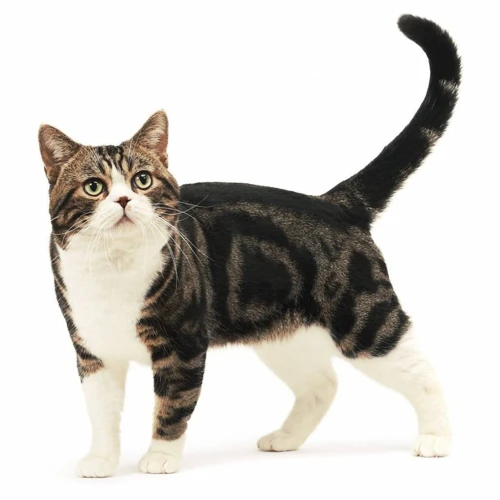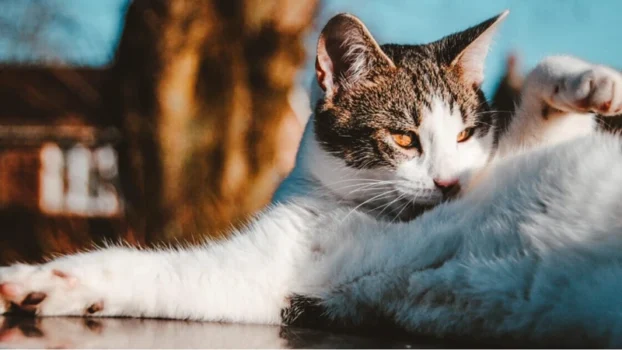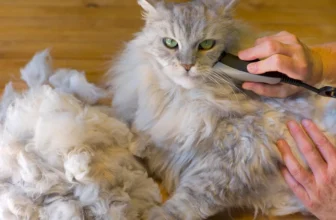As cat owners, we adore our American Wirehair cats and want them to be healthy and happy. Unfortunately, skin problems are common in cats and can cause great discomfort if left untreated. It can be distressing to see your feline friend suffer from fleas, ticks, dry and itchy skin, skin allergies, bacterial or fungal infections, parasites and mites, or even skin cancer. Identifying these issues early and treating them timely can save your cat from excruciating pain and trauma. In this article, we’ll discuss the common skin issues that affect American Wirehair cats, ways to detect them, and tips for treating and preventing these issues.
Types of Skin Issues in American Wirehair Cats

Skin issues are a common problem encountered by American Wirehair cat owners. These issues can range from mild dryness and itchiness to more serious conditions such as bacterial infections or skin cancer. Understanding the different types of skin problems that can affect your feline friend is essential in detecting and treating them early on. By doing this, you can help ensure your cat’s overall health and happiness. Learning about these topics is extremely important as it can help you treat and prevent them from occurring. Later in the article, we will explore the various skin issues that American Wirehairs can experience and how to detect and treat them. Additionally, we will share tips on how to prevent these issues from happening in the first place, which can help minimize discomfort for your furry friend. If you are interested in learning more about American Wirehair grooming techniques, feel free to check out our Wirehair Grooming Tools guide.
Fleas and Ticks
Fleas and ticks can be a common problem in cats, including American Wirehair. These external parasites can cause extreme discomfort and lead to other health problems. Regularly checking your cat for fleas and ticks is important to prevent infestations. Here are some steps you can take to detect and treat fleas and ticks in American Wirehair cats:
- Check your cat’s fur: Fleas and ticks are small, but they can still be seen with the naked eye. Look for tiny brown or black dots on your cat’s fur. Fleas can also be seen scurrying through fur.
- Look for signs of irritation: Fleas and ticks can cause your cat’s skin to become red and itchy. Keep an eye out for excessive scratching or biting at fur.
- Use flea and tick prevention medications: There are many effective medications available for flea and tick control. Talk to your veterinarian about the best options for your American Wirehair cat and follow the instructions for use closely.
- Clean your cat’s environment: Fleas and ticks can live in carpets, bedding, and furniture. Regular cleaning of your home can help reduce the risk of infestation.
- Use natural remedies: There are many natural flea and tick remedies you can try, such as apple cider vinegar or essential oils. However, it’s important to first consult with your veterinarian to ensure that these remedies are safe for your cat.
Preventing flea and tick infestations is much easier than treating them. Incorporating regular grooming practices into your American Wirehair cat’s routine is a great way to prevent the occurrence of fleas and ticks. Regular brushing, bathing, and nail trimming can help you detect and remove these pests before they become a bigger problem. For more information on grooming techniques, check out our Wirehair Grooming Schedule article.
Dry and Itchy Skin
One of the most common skin problems in American Wirehair cats is dry and itchy skin. This can be caused by a variety of factors, such as low humidity levels, allergies, or dietary deficiencies. Signs of dry and itchy skin may include excessive scratching, hair loss, and scabbing.
To alleviate dry and itchy skin in American Wirehair cats, it is recommended to provide a humidifier in the room where the cat spends most of its time. A regular grooming routine can also help remove dead skin cells and distribute natural oils evenly. Providing a healthy and balanced diet with sufficient omega-3 fatty acids can promote skin health.
For more persistent cases, it is best to consult with a veterinarian who may prescribe medications or creams to treat the underlying cause of the dry and itchy skin. Bathing with a moisturizing shampoo and conditioner can also provide relief and soothe the skin.
It is important to note that excessive bathing can actually strip the skin of its natural oils, leading to even drier and itchier skin. It is recommended to limit bathing to every 4-6 weeks, unless advised otherwise by a veterinarian.
Lastly, it is important to keep up with a regular dental hygiene routine and monitor for the formation of hairballs, as these can also contribute to skin irritation and itchiness.
Skin Allergies
Skin allergies are quite common in American Wirehair cats. Cats may be allergic to a variety of things including pollen, dust, mold, and chemicals. Some cats may be sensitive to certain types of food. Whatever the cause, skin allergies can cause significant discomfort for your pet. It is important to take your cat to the vet as soon as you notice any signs of skin allergies.
Here are some common signs of skin allergies in American Wirehair cats:
- Constant scratching, licking, and chewing on the skin
- Redness and swelling of the skin
- Bumps or rashes that ooze or scab over time
- Ear infections and hair loss
If your cat is showing any of these signs, contact your veterinarian. Your veterinarian can help you determine the cause of the allergy and prescribe the appropriate course of treatment. Allergy testing and bloodwork may be necessary to determine the root of the allergy.
Treatment typically involves giving antihistamines, steroids, or other medications to control the allergy. Your vet may also prescribe medicated shampoos or sprays to soothe the skin and speed up the healing process. In severe cases, your cat may require antibiotics to clear up any secondary infections that may have developed.
It is important to identify and address the source of the allergy to prevent future allergic reactions. Your vet may recommend changes to your cat’s diet or suggest a hypoallergenic diet. Additionally, regular grooming and bathing can help reduce the amount of allergens that your cat is exposed to.
It is important to follow up with your veterinarian and maintain good hygiene practices to prevent future skin allergy episodes. Keeping your home clean and dust-free can also help prevent skin issues. Check out our article on cleaning your American Wirehair’s ears to keep your cat healthy and comfortable.
Bacterial or Fungal Infections
Bacterial or fungal infections are common skin problems that can affect American Wirehair cats. These infections are caused by the presence of bacteria or fungi on the skin. These microorganisms can cause inflammation, itching, and discomfort on the skin. Some of the most common types of bacterial infections include Staphylococcus and Streptococcus, while the most common fungal infection is ringworm.
Signs and Symptoms of Bacterial or Fungal Infections
Below are some of the most common signs and symptoms that your American Wirehair cat may be suffering from a bacterial or fungal infection:
| Signs and Symptoms | Explanation |
|---|---|
| Skin irritation and redness | The presence of microorganisms on the skin can cause redness and inflammation. |
| Presence of scabs and bumps on the skin | The irritation can lead to the development of scabs and bumps on the skin. |
| Hair loss | Bacterial or fungal infections can cause hair loss in affected areas. |
| Intense itching and scratching | Your cat may scratch more than usual in an attempt to relieve the itchiness caused by the infection. |
| Unpleasant smell | A bacterial infection can cause a bad odor in the affected area. |
Treating Bacterial or Fungal Infections
If you suspect that your American Wirehair cat has a bacterial or fungal infection, take them to the veterinarian as soon as possible. Treatment options may include oral or topical antibiotics or antifungal medications. Your veterinarian may also recommend medicated shampoos or ointments to relieve the itchiness and inflammation.
In addition to medication, there are a few other things you can do to help your American Wirehair cat recover from a bacterial or fungal infection:
- Regular grooming: Keeping your cat groomed can help remove any dirt or debris that may contribute to infections.
- Keep the affected area clean: Use a gentle antiseptic solution to clean the affected area and prevent further infection.
- Keep your cat’s nails trimmed: This can help prevent scratching, which can worsen the infection.
- Ensure your cat has a healthy diet: A healthy diet can help boost their immune system and aid in their recovery.
- Isolate your cat: If your cat is infected with ringworm, isolate them from other pets until the infection clears up to prevent the spread of infection.
By following these tips, you can help your American Wirehair cat recover from a bacterial or fungal infection and prevent it from happening again in the future.
Parasites and Mites
Parasites and mites are a common cause of skin issues in American Wirehair Cats. These tiny creatures can cause a wide range of skin problems, from mild irritation to severe infections. Some of the most common parasites and mites that affect cats include:
- Fleas: Fleas are the most common parasite affecting cats. These tiny insects feed on the blood of animals and can cause intense itching and irritation in cats. Flea bites can also lead to secondary infections.
- Ticks: Ticks are another common parasite that can affect cats. They can carry a wide range of diseases, including Lyme disease, and can cause skin irritation and inflammation at the site of the bite.
- Mites: Mites are tiny creatures that can cause a variety of skin issues in cats. Some of the most common types of mites that affect cats include ear mites, which can cause intense itching and discomfort, and mange mites, which can lead to hair loss, scabbing, and other skin issues.
If you suspect that your American Wirehair Cat has a parasite or mite infestation, it is important to seek veterinary care right away. Your vet can perform a thorough exam and recommend an appropriate course of treatment, which may include medications, topical creams, or other interventions.
To prevent parasite and mite infestations in your cat, it is important to maintain a regular grooming routine and to keep your cat’s environment clean and free of debris. Vacuuming frequently and washing your cat’s bedding in hot water can go a long way in preventing infestations. Additionally, using flea and tick preventatives recommended by your vet can help keep these pests at bay. By taking proactive measures to prevent parasites and mites, you can help keep your American Wirehair Cat healthy and happy for years to come.
Skin Cancer
Skin cancer is a serious health concern in American Wirehair cats. According to statistics, about one-third of all cats will develop some form of skin cancer in their life. There are three common forms of skin cancer that affect American Wirehair cats: squamous cell carcinoma, basal cell carcinoma, and mast cell tumors. These cancers usually appear on the ears, nose, eyelids, and mouth and can cause significant pain and discomfort to your feline friend.
To better understand these skin cancers, let’s break down their characteristics in an html table:
| Type of cancer | Common location | Characteristics |
|---|---|---|
| Squamous cell carcinoma | Ears, nose, mouth | Slow-growing ulcer or sore that doesn’t heal, discharge, bleeding, swelling, white or yellow crusty lumps |
| Basal cell carcinoma | Head, neck, trunk, limbs | Firm, raised, red-colored bump, may ulcerate |
| Mast cell tumors | Skin, spleen, liver, lymph nodes | Multiple firm nodules on the skin, may rupture, reddish or brown color, swollen lymph nodes, gastrointestinal distress |
Skin cancer in American Wirehair cats is often caused by exposure to sunlight and harmful ultraviolet (UV) radiation. This is why it’s important to keep your cat indoors during peak sun hours and apply pet-safe sunscreen to areas like the ears and nose if your cat is going outside for a short period of time.
If you notice any suspicious lumps, sores, or skin discoloration on your cat, seek veterinarian attention immediately. Early detection and treatment can greatly improve your cat’s chances of survival and comfort. Your veterinarian may recommend treatments like surgery, radiation therapy, or chemotherapy, depending on the severity and spread of the cancer.
In addition to veterinary treatment, you can also support your cat’s overall health and immune system with dietary changes, supplements, and vitamins. This can help boost your cat’s body’s natural defenses against harmful cells and cancers and promote faster healing.
How to Detect Skin Issues in American Wirehair Cats

As a loving pet owner, it’s important to be aware of any changes in your American Wirehair cat’s appearance or behavior that could indicate the presence of a skin issue. Skin problems can be uncomfortable and painful for your feline friend and can lead to more serious health concerns if left untreated. Detecting skin issues in American Wirehair cats requires attention to detail, patience, and a keen eye for subtle changes. In this section, we will go over some common ways to detect skin issues in your American Wirehair cat, including visual cues, changes in behavior, appetite, energy levels, and observing common symptoms.
Visual cues
When it comes to detecting skin issues in your American Wirehair cat, one of the easiest ways is through visual cues. Here are some key things to look for when examining your cat:
- Bumps or Lumps: If you notice any growths or unusual bumps on your cat’s skin, it could be a sign of a more serious condition such as skin cancer.
- Redness or inflammation: Skin that appears red or inflamed may be a sign of an allergy or irritation.
- Scaly or flaky skin: If your cat’s skin appears dry or flaky, it may be a sign of a skin condition like dermatitis or psoriasis.
- Changes in pigmentation: If you notice any areas where your cat’s skin has changed color, it could be a sign of a fungal or bacterial infection.
- Scratching or excessive grooming: If your cat is constantly scratching or licking a particular area, it could be a sign of an allergy, irritation, or parasite infestation.
Keep in mind that some skin issues may not be easily visible, so be sure to also keep an eye out for changes in your cat’s behavior, energy levels, and appetite. If you notice any concerning symptoms or if you are unsure about a specific issue, it is always best to consult with your veterinarian for proper diagnosis and treatment.
Changes in Behavior
As a responsible pet owner, it is important to pay close attention to your American Wirehair cat’s behavior. Changes in behavior can often be a telltale sign of an underlying skin issue. It is important to consult with a veterinarian if you notice any changes in behavior that you are unsure about. Here are some possible changes in behavior that you should be aware of:
| Behavior Change | Possible Skin Issue |
|---|---|
| Licking or scratching constantly | Dry and itchy skin, skin allergies, parasites, or mites |
| Avoiding touch or petting | Painful skin condition or rash |
| Excessive grooming or over-cleaning | Parasites, mites, or bacterial/fungal infections |
| Changes in appetite | Skin irritation, allergy, or rash |
| Changes in energy levels | Fungal infections or skin cancer |
| Aggression or irritability | Skin pain or discomfort |
It is important to note that changes in behavior can also be caused by various other factors such as environmental changes, stress, or other health issues. It is important to observe the complete picture of your cat’s behavior along with any other symptoms they may exhibit. This will help your veterinarian to accurately diagnose and treat any underlying skin issues your American Wirehair cat may have.
Changes in Appetite
One common sign that your American Wirehair may be experiencing skin issues is a change in their appetite. Cats typically have a consistent and predictable dietary pattern, so any changes in their eating habits can be a cause for concern. Below is a table that outlines some potential causes of changes in appetite and their corresponding symptoms.
| Cause | Symptoms |
|---|---|
| Pain or discomfort | Loss of appetite, lethargy, avoiding certain movements or activities |
| Stress or anxiety | Loss of appetite, overeating, hiding or avoiding interaction, excessive grooming |
| Illness | Loss of appetite, vomiting, diarrhea, change in energy levels or behavior, weight loss |
| Side effects of medication | Loss of appetite, vomiting, diarrhea, lethargy, changes in behavior |
| Change in diet or feeding routine | Loss of appetite, overeating, vomiting, diarrhea, weight loss or gain |
It’s important to pay attention to your cat’s eating habits and monitor any changes closely. If you notice any significant or persistent changes in appetite, it’s best to consult with a veterinarian to rule out any underlying health issues. In some cases, skin issues can also be a symptom of an underlying illness or disease, so it’s important to address these issues promptly to ensure your cat stays healthy and happy.
Changes in Energy Levels
When it comes to detecting skin issues in your American Wirehair cat, changes in energy levels can be a crucial indicator. A cat that is experiencing discomfort due to skin problems may become lethargic and lose interest in activities they normally enjoy. This can be concerning for pet owners, as it can indicate their cat isn’t feeling well and needs medical attention.
One way to keep track of changes in your cat’s energy levels is to monitor their behavior and record any unusual changes. Below is a table that highlights some key behaviors to look out for and what they may indicate:
| Behavior | Possible Causes |
|---|---|
| Decreased activity and playfulness | Could be a sign of general discomfort or pain due to a skin issue, or a reaction to medications or treatments prescribed by a veterinarian. |
| Increased sleeping | Cats may sleep more when they don’t feel well, and a skin problem can make them feel uncomfortable or itchy, which can lead to increased napping. |
| Reduced grooming | Some cats will avoid grooming when they have skin problems because it can be painful or uncomfortable. This can lead to matting or tangling of their fur, which may require additional grooming or even shaving by a professional. |
| Decreased appetite | Cats with skin problems may avoid eating or drinking due to discomfort, or as a side effect of medications they are taking. This can lead to weight loss and dehydration, which can worsen their overall health. |
If you notice your American Wirehair exhibiting any of these symptoms, it’s important to take them to a veterinarian as soon as possible for an evaluation. A veterinarian can help determine the root cause of the issue and recommend treatment options that can help improve your cat’s energy levels and overall health.
Observing Common Symptoms
It is essential to observe common symptoms of skin issues in American Wirehair cats to detect any skin problems early on. Here are some common symptoms that you should be on the lookout for:
| Symptom | Description |
|---|---|
| Excessive Scratching | American Wirehair cats may scratch excessively due to flea and tick bites, dry and itchy skin, inflammation, or an allergic reaction. |
| Crusty or Scaly Skin | Crusty or scaly skin on your cat can be a sign of ringworm, a fungal infection that can be easily transmitted to other cats or humans. |
| Redness and Swelling | Redness and swelling on the skin can be a sign of a bacterial or fungal infection or an allergic reaction. |
| Bald Spots | American Wirehair cats with bald spots on their skin may be suffering from a skin allergy or a parasitic infestation such as mange. |
| Unpleasant Odor | An unpleasant odor coming from your cat’s skin can be a symptom of a bacterial or fungal infection. |
| Blackheads or Pimples | Blackheads or pimples on the skin can be a sign of feline acne, a condition that is easily manageable with proper hygiene practices. |
If you notice any of these symptoms on your American Wirehair cat’s skin, it is important to take action and seek veterinary care as soon as possible. Early detection and treatment can prevent the problem from worsening and causing discomfort to your feline friend.
Tips for Treating Skin Issues in American Wirehair Cats

As a loving American Wirehair cat owner, noticing any signs of discomfort or skin issues can be distressing. Fortunately, there are various ways to treat skin problems in your feline friend. Here are some helpful tips to get your American Wirehair back to their healthy and playful selves. With proper care and attention, you can address these issues and ensure your furry friend is comfortable and happy.
Visit the Veterinarian
Keeping your American Wirehair cat healthy and happy involves taking good care of their skin. If you notice any abnormalities in their coat or skin, the first thing you should do is seek assistance from a veterinarian. Whether it’s a minor skin irritation or a more serious condition, your vet can evaluate your cat’s health and provide a treatment plan to resolve the issue.
Why is visiting the vet important?
Visiting the vet is crucial in detecting and treating skin issues in American Wirehair cats. Your vet will provide a thorough examination of your cat’s skin and help you determine the root cause of their skin condition. They will also check for any underlying health issues that may be contributing to the skin problem. The earlier a skin condition is detected, the better the outcome of treatment.
What should you expect during a vet visit?
During a vet visit for your cat’s skin concerns, you can expect the following steps:
| Step | Description |
|---|---|
| Physical Examination | Your vet will perform a physical examination of your cat’s skin to identify any abnormalities. They may take a skin sample or perform a skin scraping to determine the cause of your cat’s skin problem. |
| Medical History | Your vet will ask you questions about your cat’s medical history, including any past skin conditions or allergies, and their diet. |
| Diagnostics | Your vet may recommend a blood test, urine test, or skin biopsy to diagnose your cat’s skin condition. They may also conduct allergy tests to determine the cause of your cat’s allergic reaction. |
| Treatment | Based on the diagnosis, your vet will prescribe a treatment plan that may include medications, creams, or dietary changes. They will also explain how to administer medication and provide a timeline for treatment. |
Final thoughts
Visiting the vet is an important step in ensuring your American Wirehair cat’s skin remains healthy. Don’t hesitate to consult your vet if you notice any changes in your cat’s skin or coat. It’s always better to catch a skin issue early and prevent it from escalating into a more serious health concern.
Medications and Creams
One common way to treat skin issues in American Wirehair Cats is through the use of medications and creams. These treatments are often prescribed by a veterinarian and can be effective in alleviating symptoms and addressing the root cause of the issue.
Below is a table of some common medications and creams used for different types of skin issues in American Wirehair Cats:
| Issue | Treatment |
|---|---|
| Fleas and Ticks | Topical flea and tick preventatives such as Frontline or Advantage |
| Dry and Itchy Skin | Moisturizing creams or ointments such as Eucerin or Aquaphor |
| Skin Allergies | Antihistamines such as Benadryl or steroid creams such as hydrocortisone |
| Bacterial or Fungal Infections | Antibiotics or antifungal medications prescribed by a veterinarian |
| Parasites and Mites | Prescription medications such as Revolution or Advantage Multi |
| Skin Cancer | Cryotherapy or surgery to remove the affected area |
It’s important to note that while medications and creams can be effective treatments, they should always be used under the guidance of a veterinarian. Dosage amounts and frequency should be strictly followed to ensure the safety and health of the cat. Additionally, some medications may have side effects that can be harmful if not monitored properly.
In some cases, medications and creams may be used in conjunction with other treatment methods such as bathing and grooming, dietary changes, and supplements/vitamins for optimal results. A veterinarian can provide personalized recommendations for the best treatment plan for a specific case of skin issue in an American Wirehair Cat.
Bathing and Grooming
Maintaining a regular grooming and bathing routine can be essential in treating and preventing skin issues in American Wirehair cats. Here are some tips to keep in mind:
- Use cat-specific grooming tools: Regular brushing can help prevent mats and tangles, and distribute natural oils throughout your cat’s coat. Use a brush specifically designed for cats, and be gentle while brushing to avoid irritating their sensitive skin.
- Choose a cat-friendly shampoo: When bathing your American Wirehair cat, use only shampoos made for felines. Human shampoos can contain ingredients that can cause adverse reactions and even harm your cat. Also, avoid using shampoos with strong fragrances, as these can irritate your cat’s sensitive sense of smell.
- Be careful with water temperature: Make sure to use lukewarm water, as water that is too hot or too cold can be uncomfortable for your cat. Test the water with your hand before bathing to ensure it’s at the right temperature.
- Thoroughly rinse: After applying shampoo, ensure that you rinse all of it out of your cat’s coat. Any leftover shampoo can cause skin irritation.
- Dry your cat gently: Use a soft, absorbent towel to dry your cat after bathing. Avoid using a hairdryer, as the heat can be too intense and cause burns or discomfort. If your cat allows it, you can use a low heat setting on a hairdryer, but always keep it at a safe distance from your cat.
By following these grooming practices, you can help prevent skin problems in your American Wirehair cat and keep their coat healthy and shiny. However, if your cat is already experiencing skin issues, it’s essential to visit your veterinarian for proper diagnosis and treatment.
Dietary Changes
One of the most effective ways to treat skin issues in American Wirehair cats is through dietary changes. What your cat eats can have a significant impact on their skin health. Here are some dietary changes you can make to help treat skin issues in your American Wirehair cat:
- Switch to a high-quality cat food: Your cat’s food should be high in protein and low in carbohydrates. Look for a cat food that lists a high-quality protein source as the first ingredient and is free from fillers and by-products.
- Consider a hypoallergenic diet: If your cat has a food allergy that is causing their skin issues, switching to a hypoallergenic diet may be necessary. These diets are specially formulated to avoid common allergens such as chicken, beef, and corn.
- Introduce omega-3 fatty acids: Omega-3 fatty acids are good for skin and coat health. You can introduce omega-3s into your cat’s diet by adding fish oil or flaxseed oil to their food.
- Stay hydrated: Make sure your cat is drinking enough water to keep their skin hydrated and healthy.
- Avoid potential trigger foods: Some cats may have specific food intolerances that can cause skin issues. Common trigger foods include dairy, wheat, and soy. Removing these foods from your cat’s diet may help improve their skin health.
Remember to always consult with your veterinarian before making any significant changes to your cat’s diet. They can help you choose the right food for your cat and ensure that they are getting all the necessary nutrients. By making these dietary changes, you can help improve your American Wirehair cat’s skin health and overall well-being.
Supplements and Vitamins
Supplements and vitamins can be incredibly helpful for treating and preventing skin issues in American Wirehair cats. Here are some of the most effective options:
- Fatty Acid Supplements: These supplements can help improve skin health and reduce inflammation. Omega-3 and omega-6 fatty acids are especially beneficial and can be found in fish oil supplements or in foods like salmon and flaxseed.
- Vitamin E: This antioxidant can promote healthy skin by protecting it from damage caused by free radicals. Additionally, it can help reduce inflammation and itching. You can give your cat vitamin E supplements or add vitamin E-rich foods to their diet, such as almonds, spinach, and sweet potatoes.
- Biotin: This B vitamin is essential for healthy skin and coat. Biotin supplements can help improve the overall quality of your cat’s skin and fur. Foods like eggs, liver, and salmon are also rich in biotin.
- Zinc: This mineral is crucial for healthy skin and can help boost the immune system. Zinc supplements can help improve your cat’s skin health and prevent infections. Foods like beef, pork, and chicken are good natural sources of zinc.
- Probiotics: These beneficial bacteria can help improve your cat’s immune system and reduce inflammation. Probiotic supplements can also help improve digestive health, which in turn can lead to healthier skin. You can find probiotic supplements specifically designed for cats or add probiotic-rich foods like yogurt or kefir to their diet.
It’s important to remember that supplements and vitamins should never be used as a substitute for proper medical treatment from a veterinarian. Your vet can help you determine the best supplements to give your cat based on their individual needs and health concerns. Additionally, always follow the recommended dosage instructions on supplement packaging and monitor your cat for any adverse reactions.
Follow-up and Maintenance
Just like any other health condition, treating skin issues in your American Wirehair cat requires follow-up and maintenance to ensure that the issue has been resolved completely and doesn’t reoccur.
Here are some ways to follow-up and maintain your cat’s skin health:
- Regular Vet Visits: It’s important to schedule regular vet visits to keep your cat’s health in check. Your vet will be able to monitor your cat’s progress and suggest any changes to the treatment plan if necessary.
- Consistent Use of Medications and Creams: Make sure to consistently follow the dosage and application instructions for any medications or creams prescribed by your vet.
- Continue Bathing and Grooming: Regular bathing and grooming is essential for maintaining your cat’s skin health. Continue to follow a grooming routine to keep their coat and skin clean and healthy.
- Dietary Changes: If your cat’s skin issue was caused by a dietary deficiency or intolerance, it’s important to continue feeding them a diet that’s suited to their needs. Consult with your vet to find the best food for your cat’s specific condition.
- Supplements and Vitamins: Your vet may recommend supplements or vitamins to support your cat’s skin health. Make sure to continue giving them as prescribed.
By following these tips and maintaining a consistent routine, you can help prevent future skin issues in your American Wirehair cat and keep them healthy and happy.
Preventing Skin Issues in American Wirehair Cats
As a pet owner, preventing skin issues in your American Wirehair is crucial to ensure that your feline friend is healthy and happy. Skin issues can be painful and stressful for your cat, and costly for you as the owner. By taking preventative measures, you can significantly reduce the risk of your American Wirehair developing common skin issues, such as flea and tick infestations, itchiness, and allergies. In this section, we will explore key steps that you can take to protect your pet’s skin and keep them feeling comfortable and content.
Insect and Parasite Prevention
One of the most effective ways to prevent skin issues in American Wirehair cats is by taking steps to protect them from insects and parasites. Here are some tips for keeping your cat free from these pests:
- Use flea and tick preventatives: Flea and tick preventatives come in many forms, including topical treatments, oral medications, and collars. Consult with your veterinarian to find the best option for your cat, and make sure to follow the instructions carefully.
- Keep your cat indoor: Indoor cats are less likely to encounter fleas, ticks, and other parasites than outdoor cats. If you do allow your cat outdoors, make sure to keep them on a leash or in a secure outdoor enclosure.
- Clean and vacuum regularly: Fleas and ticks can live in carpets, bedding, and furniture, so it’s important to clean and vacuum your home regularly to reduce the risk of infestation.
- Check your cat regularly: Regularly check your cat for signs of fleas, ticks, and other parasites. Look for small black specks on your cat’s skin or fur, which may be flea dirt or eggs.
- Keep your yard tidy: Keep your yard free of tall grass and weeds, which can attract fleas, ticks, and other pests. Also, make sure to remove any standing water, which can be a breeding ground for mosquitoes.
- Use natural remedies: Some natural remedies, such as essential oils, can help repel fleas, ticks, and other pests. However, it’s important to do your research and consult with your veterinarian before using any natural remedies on your cat. Some essential oils can be harmful to cats.
By taking these steps to prevent insects and parasites, you can help keep your American Wirehair cat healthy and free from skin issues. Remember to consult with your veterinarian and follow their recommendations to ensure that your cat stays happy and healthy.
Regular Grooming and Hygiene Practices
One of the most effective ways to prevent skin issues in American Wirehair cats is to regularly groom and practice good hygiene. This can help remove any potential irritants or pests that may be causing skin problems. Here are some regular grooming and hygiene practices that can help prevent skin problems in your cat:
| Brushing | Regular brushing can help remove loose fur, dirt, and debris from your cat’s coat. This can prevent matting and reduce the risk of skin irritation or infection. Use a comb or brush specifically designed for cats, and be gentle to avoid hurting your cat while grooming. |
| Bathing | Bathing your cat can be another effective way of cleaning their skin. However, it’s important to not bathe your cat too frequently, as this can actually dry out their skin and cause irritation. Aim to bathe your cat once every few months or as directed by your veterinarian. |
| Trimming nails | Long nails can not only be painful for your cat, but they can also harbor dirt and bacteria that can cause skin infections. Regular nail trimming can prevent this and keep your cat’s paws healthy. If you’re unsure how to trim your cat’s nails, ask your veterinarian for advice or visit a groomer. |
| Cleaning ears and eyes | American Wirehair cats are prone to ear and eye infections, so regular cleaning is important. Use a cotton ball or pad and a gentle cleanser specifically designed for cats. Avoid using Q-tips, as they can push debris further into your cat’s ear canal and cause damage. |
| Dental care | Regular dental care can not only prevent bad breath, but it can also prevent gum disease and bacterial infections that can affect your cat’s skin. Brush your cat’s teeth regularly with a toothbrush and toothpaste designed for cats, and consider dental treats or toys to promote healthy teeth and gums. |
| Checking for pests | Regularly checking your cat for any signs of fleas, ticks, or mites can prevent an infestation and reduce the risk of skin irritation or infection. Use a flea comb to check for fleas, and inspect your cat’s skin for any small bumps or bites. |
Remember that prevention is key to maintaining your American Wirehair cat’s health and preventing skin problems. By regularly practicing these grooming and hygiene habits, you can keep your cat’s skin healthy and prevent the need for more invasive treatments in the future.
Keeping Your Cat Indoors
One effective way to prevent skin issues in American Wirehair cats is by keeping them indoors. While it may be tempting to let them roam outside, this can expose them to a variety of potential problems including fleas, ticks, parasites, and infections. Additionally, outdoor activities can cause scratches, wounds, and sunburns that can lead to further skin issues.
Below are some of the benefits of keeping your American Wirehair cat indoors:
| Benefits of Indoors | Description |
|---|---|
| Reduced Risk of Injury | Indoor cats are less prone to injuries caused by cars, other animals, and other dangers that are present outside. |
| Better Protection Against Parasites | Indoor cats are less likely to be exposed to fleas, ticks, and other parasites that can cause skin problems. |
| Less Sun Exposure | Outdoor cats are at a higher risk of sunburn, which can cause skin problems. By keeping your cat indoors, you can control their sun exposure and reduce the risk of sunburn. |
| Controlled Environment | Indoor cats live in a controlled environment that is less likely to harbor skin-irritating plants, toxins, or dangerous objects. |
While American Wirehair cats can get bored when kept indoors, there are ways to keep them entertained and happy. For example, you can provide them with interactive toys, scratching posts, and a comfortable space to nap. Plus, you will have peace of mind knowing that your cat is safe and healthy.
Keeping your American Wirehair cat indoors is a great way to prevent skin issues and promote their overall health and well-being. Take some time to create a comfortable living space for your feline friend and enjoy their company for years to come.
Conclusion
In conclusion, taking care of your American Wirehair cat’s skin is crucial to their overall health and well-being. As a pet parent, it’s essential to stay vigilant and identify any skin issues early on to prevent them from becoming more severe. Visiting the veterinarian and following their recommended treatment plan is crucial, as some skin issues may require medication or a change in diet to resolve.
Regular grooming and hygiene practices can also go a long way in preventing skin problems in your cat. Keeping your cat indoors can also reduce their exposure to insects and parasites that can cause skin issues. It’s important to make sure your cat is up-to-date on all their vaccinations and flea/tick preventative medications to keep them healthy.
Remember, your American Wirehair cat relies on you to take care of them, including their skin health. With proper care, your cat can enjoy a happy and healthy life, free of skin issues. So be observant, take action when needed, and provide your furry friend with the love and care they deserve.
Frequently Asked Questions
1. Can fleas and ticks be prevented in American Wirehair cats?
Yes, regular use of flea and tick prevention medication can help prevent infestations in American Wirehair cats.
2. How can you tell if your American Wirehair cat has dry and itchy skin?
You may notice your cat scratching or chewing at their skin, or the skin may appear flaky and irritated.
3. What are common symptoms of skin allergies in American Wirehair cats?
Symptoms may include itching, redness, swelling, and possible hair loss in the affected area.
4. Can bacterial or fungal infections be contagious to other pets or humans?
Yes, some bacterial or fungal infections can be contagious to other pets or even humans. It’s important to seek veterinary treatment and practice good hygiene to prevent the spread of infection.
5. Is skin cancer common in American Wirehair cats?
While skin cancer can occur in cats of any breed, it is not particularly common in American Wirehair cats.
6. How do you visually detect skin issues in American Wirehair cats?
You may notice changes in the texture, color, or appearance of your cat’s skin, such as redness, swelling, or flakiness. Excessive scratching or chewing at the skin may also be a sign of an issue.
7. How can you treat skin allergies in American Wirehair cats?
Your veterinarian may prescribe medications such as antihistamines or corticosteroids, or recommend dietary changes or supplements to alleviate symptoms.
8. What dietary changes can help prevent skin issues in American Wirehair cats?
Including omega-3 fatty acids and other essential nutrients in your cat’s diet can help promote healthy skin and coat.
9. How often should American Wirehair cats be groomed?
Regular grooming, including brushing and bathing as needed, can help prevent skin issues and promote healthy skin and coat. The frequency of grooming may depend on your cat’s individual needs and coat type.
10. Can keeping an American Wirehair cat indoors help prevent skin issues?
Keeping your cat indoors can help prevent exposure to parasites and other potential skin irritants, but it is still important to practice good grooming and hygiene habits to maintain healthy skin.







